The principle of the best interests of the child has been the subject of extensive consideration in academic, operational and other circles. Legal documents relating to the protection of children, including those adopted by UNHCR's Executive Committee on children of concern to the Office, systematically refer to it. How to apply this principle in practice, however, often remains challenging for UNHCR and its partners. Limited guidance is available on how to operationalize the best interests principle. UNHCR's Guidelines on Determining the Best Interests of the Child are intended as one step to help fill this gap.
Among others, the Guidelines describe a formal mechanism to determine the best interests of the child. BID procedures should not, however, be established in isolation of other protection measures taken for the benefit of children falling under UNHCR's mandate. The mechanism is thus designed as part of a comprehensive child protection system.
A best interests determination (BID) describes the formal process, with strict safeguards, that UNHCR has established for decisions of a similar magnitude. A BID is particularly relevant for refugee children, although in certain circumstances best interests determinations may also need to be carried out by UNHCR for other categories of children. Building on the practice of domestic child protection systems, this publication offers guidance (Chapter 1) on how to apply the best interests principle in practice, and defines (Chapter 2) the three situations in which UNHCR must undertake a BID. These include (i) the identification of the most appropriate durable solution for unaccompanied and separated refugee children, (ii) temporary care decisions for unaccompanied and separated children in certain exceptional circumstances, and (iii) decisions which may involve the separation of a child from parents against their will.
Chapter 3 of the Guidelines provides detailed guidance on the procedure. This consists essentially of two key steps: collecting and analysing all relevant information; and balancing all relevant factors to determine which of the possible options is in the best interests of the child. The first step can be undertaken either directly by UNHCR or entrusted to partners, usually NGOs, whereas the second step should normally be taken by a multi-disciplinary panel. Chapter 3 also provides guidance on how to weigh the relevant factors, when determining a child's best interests.
The involvement of partners is essential when it comes to applying these Guidelines, so as to ensure that determining the child's best interests takes place as part of a comprehensive child protection system. Moreover, while these Guidelines are primarily intended as a tool for UNHCR and its partners in the field, its contents may also be helpful to States when extending their domestic child protection systems to displaced or stateless persons.
These Guidelines in their final version have been produced following two years of field testing the provisionally released version of May 2006 and have incorporated extensive feedback from UNHCR partners. A French translation is planned for the second half of 2008.

